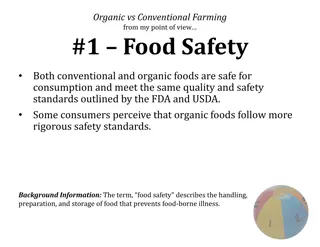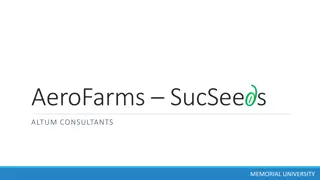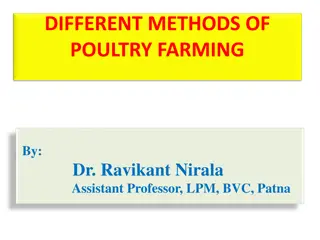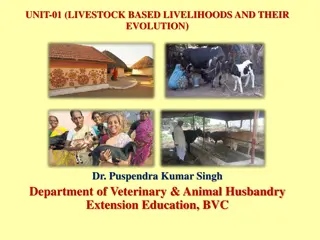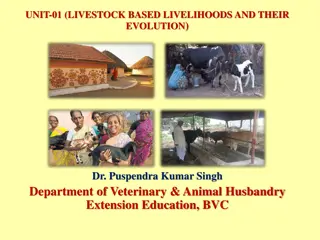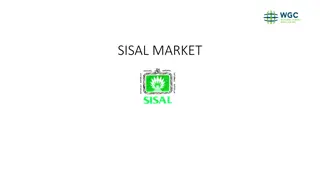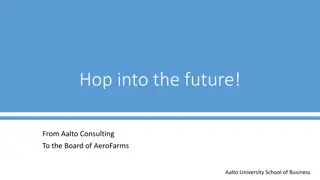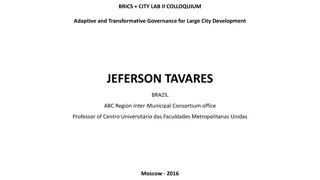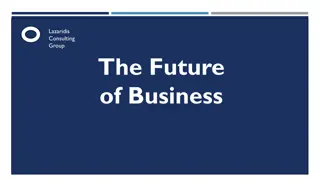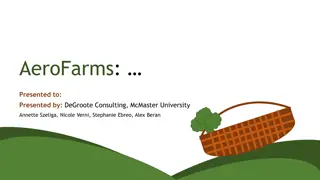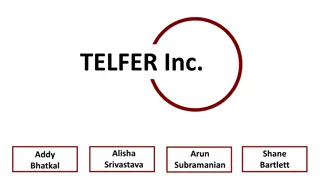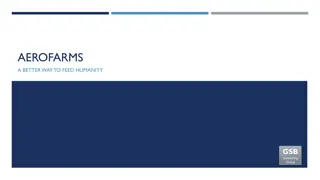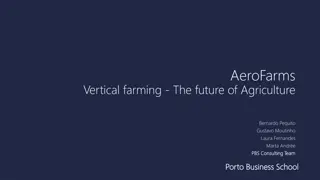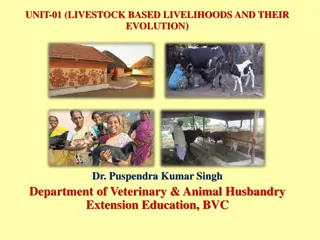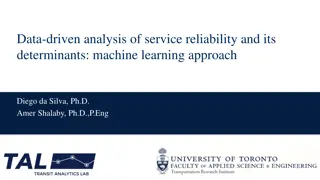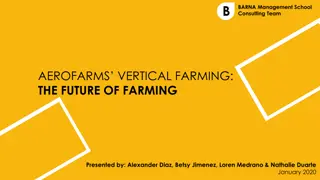Insper Sao Paulo Brazil AeroFarms: Revolutionizing Vertical Farming
Insper Sao Paulo Brazil AeroFarms, the world's largest vertical farming company, is leading the way in sustainable crop cultivation. With a focus on aeroponics and innovative technology, AeroFarms aims to transform agriculture by offering fresh, nutrient-rich produce closer to consumers. Discover how this capital-intensive business is redefining farming practices with its efficient operations and environmentally responsible approach.
Download Presentation

Please find below an Image/Link to download the presentation.
The content on the website is provided AS IS for your information and personal use only. It may not be sold, licensed, or shared on other websites without obtaining consent from the author.If you encounter any issues during the download, it is possible that the publisher has removed the file from their server.
You are allowed to download the files provided on this website for personal or commercial use, subject to the condition that they are used lawfully. All files are the property of their respective owners.
The content on the website is provided AS IS for your information and personal use only. It may not be sold, licensed, or shared on other websites without obtaining consent from the author.
E N D
Presentation Transcript
Insper | Sao Paulo - Brazil AeroFarms The World Largest Vertical Farming Company presenting to: Ed Harwood David Rosenberg Marc Oshima presented by: Decio Soares Nahana Caetano Romilson Teles Tobias Walzberg
agenda 1 | Introduction 2 | Analysis of the situation 3 | Assumptions 4 | Alternatives 5 | Recommendation 6 | Implementation 7 | Wrap-up
agenda Business dilemmas Could aeroponics and vertical farming be the future of crop cultivation, without cultivating high calories- based protein and grains? 1 Could it be a profitable and sustainable business model? 2 How could it be less dependent of capital and more energy sufficient? 3 Could consumers be more interested in vertical farming products? 4
AeroFarms The World Largest Vertical Farming Company The Company Newark, NJ, USA Portfolio Brand Dream Greens Founded in 2011 Focused on leafy vegetables Farming 4.0 Data on 250 crops Mission: transform agriculture (environmentally responsible farms) Possible future expansion to berries, peppers, cucumbers and fruits Revenue: US$ 50 million (2019) No staple crops (grains or proteins) Venture capital: US$ 238 million (until July 2019) Capital intensive business
AeroFarms The World Largest Vertical Farming Company Business operations 280+ operation procedures 9 farms located globally (7 in the USA, 1 in Saudi Arabia, 1 in China) 130 employees (trained and qualified) Vertical farming + patented cloth + led lights -95% water 10x +CO2 Less use of fertilizers and no use of pesticides Close to consumer markets (up to 15 miles) Short product-to-market cycle Low transportation cost Data analytics
analysis of the situation
- 390 times more efficient (land use) than traditional farms Reduced transportation costs Patented technology More pest control No chemical fertilizers used Closer to large consumers area Sweeter and higher level of vitamins Dell Inc. partnership (IoT) No use of soil - - High fixed costs per square meter Only green salads and no high- calories grains High carbon emission due to energy consumption (LED) W S - - - - - - - - - - - New methods of food production New legislation (D.C. Urban Farming and Food Security Act) encouraging urban farming - More carbon emission (high energy consumption) New legislation to block international funding for startups Trade war Subsidies required for energy consumption Difficulty to find qualified professional Hydroponic system high growth T O - - - - -
- 390 times more efficient (land use) than traditional farms Reduced transportation costs Patented technology More pest control No chemical fertilizers used Closer to large consumers area Sweeter and higher level of vitamins Dell Inc. partnership (IoT) No use of soil - - High fixed costs per square meter Only green salads and no high- calories grains High carbon emission due to energy consumption (LED) W S - - - - - - - - - - - New methods of food production New legislation (D.C. Urban Farming and Food Security Act) encouraging urban farming - More carbon emission (high energy consumption) New legislation to block international funding for startups Trade war Subsidies required for energy consumption Difficulty to find qualified professional Hydroponic system high growth T O - - - - -
- 390 times more efficient (land use) than traditional farms Reduced transportation costs Patented technology More pest control No chemical fertilizers used Closer to large consumers area Sweeter and higher level of vitamins Dell Inc. partnership (IoT) No use of soil - - High fixed costs per square meter Only green salads and no high- calories grains High carbon emission due to energy consumption (LED) W S - - - - - - - - - - - New methods of food production New legislation (D.C. Urban Farming and Food Security Act) encouraging urban farming - More carbon emission (high energy consumption) New legislation to block international funding for startups Trade war Subsidies required for energy consumption Difficulty to find qualified professional Hydroponic system high growth T O - - - - -
- 390 times more efficient (land use) than traditional farms Reduced transportation costs Patented technology More pest control No chemical fertilizers used Closer to large consumers area Sweeter and higher level of vitamins Dell Inc. partnership (IoT) No use of soil - - High fixed costs per square meter Only green salads and no high- calories grains High carbon emission due to energy consumption (LED) W S - - - - - - - - - - - New methods of food production New legislation (D.C. Urban Farming and Food Security Act) encouraging urban farming - More carbon emission (high energy consumption) New legislation to block international funding for startups Trade war Subsidies required for energy consumption Difficulty to find qualified professional Hydroponic system high growth T O - - - - -
- 390 times more efficient (land use) than traditional farms Reduced transportation costs Patented technology More pest control No chemical fertilizers used Closer to large consumers area Sweeter and higher level of vitamins Dell Inc. partnership (IoT) No use of soil - - High fixed costs per square meter Only green salads and no high- calories grains High carbon emission due to energy consumption (LED) W S - - - - - - - - - - - New methods of food production New legislation (D.C. Urban Farming and Food Security Act) encouraging urban farming - More carbon emission (high energy consumption) New legislation to block international funding for startups Trade war Subsidies required for energy consumption Difficulty to find qualified professional Hydroponic system high growth T O - - - - -
competition vertical farms hydroponic system Gotham Greens Google s Alphabet X Lufa Farms VertiCrop FarmedHere
INTERNAL Focus on vertical farms aeroponics technology Use of data analytics (IoT & Machine Learning) 25 farms by 2022 EXTERNAL Decrease of arable land by 1/3 in 2050 (comparable to 1970) Less impact of climate change in aeroponics technology World population of 9 billion people by 2050
Main challenges Issues to tackle Mass production Requires additional Capex High prices Increases revenues 1. Crop Portfolio North America Focus on USA large consumer market Asia Pacific Alternative to current suppliers 2. Expansion Markets Urban/ suburban Close to consumers, high Capex Rural High transportation costs, low capex 3. Location US based Local funding / subsidies Global Additional Venture Capital 4. Funding LED Consistent technology Innovation New/improved technologies 5. Carbon footprint Specialized Need for training / high cost Simple Lower cost / higher availability 6. Talent acquisition
Decision matrix Main questions going forward Leaves Staples Vegetables Fruits/Berries 1. Crop Portfolio North America Asia Pacific Europe Rest of the world 2. Expansion Markets Urban Sub-urban Rural 3. Location Venture Capital Internal Revenues Govnmt. Funding 4. Funding LED improved New technology 5. Carbon footprint LED as is Proprietary tech scalability Simplified process Tech use 6. Talent acquisition
Decision matrix Main questions going forward Leaves Staples Vegetables Fruits/Berries 1. Crop Portfolio North America Asia Pacific Europe Rest of the world 2. Expansion Markets Urban Sub-urban Rural 3. Location Venture Capital Internal Revenues Govnmt. Funding 4. Funding LED improved New technology 5. Carbon footprint LED as is Proprietary tech scalability Simplified process Tech use 6. Talent acquisition
Recommendation Forward going strategy Focus on: Locally optimizing portfolio and adding high value crops Optimized production processes Generate cash flow and revenues on the US market to reduce dependence on Venture Capital Asia expansion through international Venture Capital (spin-off / separate company) Development of new businesses: capitalize on proprietary technology This strategy delivers: Higher revenues in the short term Optimized use of space in USA Use of venture capital to further assist expansion Additional revenue streams to core business model
Implementation plan Forward going strategy 1H20 2H20 1H21 2H21 1H22 2H22 + costs efficiency gains netted costs + Capex efficiency gains Simplify processes (hiring less qualified workforce) Increase local training programs +revenues Positioning claim + costs + consumer claim + revenues Lobbying + revenues Portfolio migration high-value crops + Capex, + revenues Saudi Arabia Expansion + revenues Patent revision Small farm format Robots Processes +revenues VIP consumers +revenues Partnership USA - Capex Relocation + Capex, + revenues Expansion + Capex, + revenues Israel + Capex, + revenues Others Asia-Pacific + revenues + revenues Franchising New business
Implementation plan Financial assumptions U.S.A 1. Low Capex (VC) availability 1. Funding based on increased revenues due to local portfolio optimization and product positioning 2. Location revision to minimize future Capex need 3. Process simplification and technology improvement to reduce costs 4. Additional revenue streams needed Asia Pacific 1. Venture Capital availability 1. Expansion based on VC investment 2. Use of acquired knowledge in Saudi Arabia and China 3. Revenue increment through expansions and local portfolio optimization New Businesses 1. Patent revision 1. Capitalizing on acquired experience and developed proprietary technology 2. Expansion through franchising optimizing farm size and format
1 Future of crop cultivation? 2 Profitable and sustainable? wrap-up 3 Energy sufficient? 4 Interested consumers?
thank you merci beaucoup obrigado
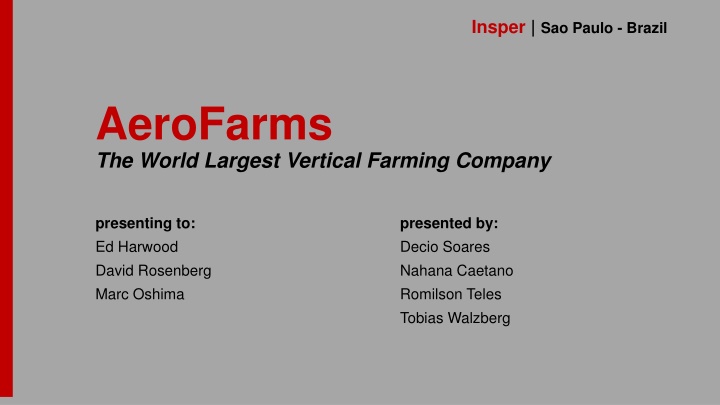

![Halal_Chicken_from_Brazil-_Ensuring_Quality_and_Authenticity[1]](/thumb/86918/halal-chicken-from-brazil-ensuring-quality-and-authenticity-1.jpg)
